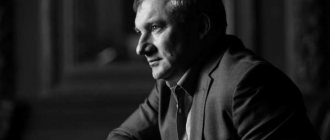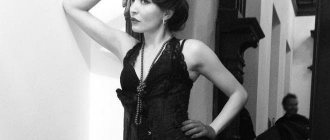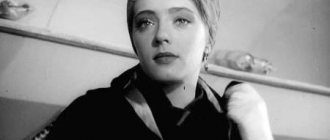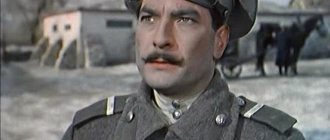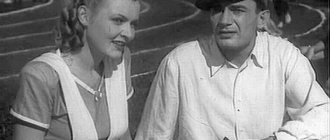Biography
Grigory Rasputin is a well-known and controversial figure in Russian history, debates about which have been going on for a century. His life is filled with a mass of inexplicable events and facts related to his closeness to the family of Emperor Nicholas II and his influence on the fate of the Russian Empire. Some historians consider him an immoral charlatan and a swindler, while others are confident that Rasputin was a real seer and healer, which allowed him to gain influence over the royal family.
Rasputin Museum in Pokrovsky
On the road from Tyumen to the main tourist center of the Trans-Urals - the city of Tobolsk - you should definitely stop by the village of Pokrovskoye. Here, in the homeland of Grigory Rasputin, there is a house-museum dedicated to this legendary man.
Grigory Efimovich Rasputin was born in the village of Pokrovskoye in 1869. Having lived here until he was 28 years old, he went to travel around Russia for several years in search of peace of mind. Among other things, he went to Verkhoturye to venerate the relics of Simeon of Verkhoturye. Once in the capital, Rasputin was able to get closer to the Romanovs (it is believed that he was able to help Tsarevich Alexei suffering from hemophilia) and spent 11 years next to the royal family. Rasputin had enormous influence on the royal family, which had unlimited trust in him and often consulted with him.
But at the same time, Rasputin also had many enemies at court. Not everyone liked his influence on the king. As a result, in 1916, Rasputin was brutally murdered. The reprisal against him was sophisticated. First, he ate several poisoned cakes, then knocked out two glasses of wine with potassium cyanide. When the poison had no effect on the horror of the conspirators, they fired two shots at the old man. But even after this, Rasputin remained alive. To finish off Rasputin, they threw him into an ice hole...
A little more than a year later, representatives of the Romanov family also went to another world. There is a mixed opinion about Rasputin: some consider him a prophet and healer, while others consider him a drunkard and libertine. His image is surrounded by various legends.
The House-Museum of Grigory Rasputin in the village of Pokrovskoye is a private museum created through the efforts of a married couple - Vladimir and Marina Smirnov. They took up this matter back in 1990, having become interested in the personality of Grigory Rasputin. At that time, several old-timers who remembered Rasputin were still alive. The private museum created by the couple out of sheer enthusiasm became one of the first in our country.
Over the past decades, the Smirnovs have collected a lot of information about Rasputin and found exhibits related to him.
They also act as tour guides in their museum, surprising visitors with interesting facts and dispelling some myths. By the way, the Smirnovs have already written several books about G.E. Rasputin.
The museum looks like an ordinary village house. Unfortunately, this is not the house in which Rasputin lived. The old man's house, which stood opposite, was demolished during Soviet times. At first, the museum was located in a house that belonged to pilot Zubov. It is known that Rasputin visited this house, visiting Zubov. In 2009, the museum moved to a new building.
A memorial stone was erected at the gates of the house-museum in memory of the royal family who stayed here several months before their execution. The inscription is carved on the stone: ““In the village. Pokrovsky there was a harness, for a long time they stood right in front of the house of Grigory (Rasputin) ... "April 14, 1918. From the diary of Emperor Nicholas II." Rasputin himself was no longer alive then.
In the courtyard of the museum you can see old carved frames. This is all that remains from the home of Grigory Rasputin. In the museum you will see exhibits that Rasputin used: a dressing table with a cracked mirror, an old forged chest, a spoon and a dish with the personal monogram of Alexandra Fedorovna Romanova, an icon of Simeon of Verkhoturye, in front of which Gregory prayed. All objects associated with Rasputin are attributed mystical properties.
But still, the most famous exhibit of the museum is Rasputin’s old Viennese chair. According to popular legend, the chair has healing properties - it treats male diseases, increases potency, and helps against childlessness. Many people specially come here from far away just to sit on this chair, which gets rid of illnesses.
The founders of the museum managed to find and acquire photographs of Grigory Rasputin and his family with dedicatory inscriptions, as well as his personal notes. One of the museum's expositions is products produced under the Rasputin brand. Nearby is a large collection of books about this man, and not only in Russian.
There is a stand in the museum with photographs of famous visitors. At various times, such celebrities as the legendary musical group Boney-M (they even have a song “Rasputin”), the head of Rusnano Anatoly Chubais, statesman Igor Shuvalov, the former governor of the Tyumen region, and now the mayor of Moscow Sergei Sobyanin, visited here. journalist Leonid Parfenov, fashion designer Vyacheslav Zaitsev and others. Journalists from various countries have been here.
In 2005, the museum received the Yuri Senkevich Tourist Prize in the category “For enthusiasm in the development of museum affairs.”
How to get to the Rasputin Museum?
The Rasputin Museum is located in the Yarkovsky district of the Tyumen region. From Tyumen you need to drive towards Tobolskaya for about 80 kilometers, then turn off the highway following the sign to the village of Pokrovskoye. There is also a sign here informing about the Rasputin house-museum located in the village. The museum is located on the street. Sovetskaya, 79.
Rasputin Museum in Pokrovsky on the map:
Order now!
Your ad could be here!
https://nashural.ru Your advertisement will be seen by thousands of people a day
Interesting? Tell your friends!
We need your help!
The Our Ural project existed for a long time using money from the sale of our books. Unfortunately, paper books are becoming less and less successful every year. If you want there to be a portal like “Our Ural” , please support us financially. Any help from you will be valuable, and from raindrops, streams are first formed, and then powerful rivers that flow into the seas. Thank you!
"SDM-Bank"
Childhood and youth
Rasputin Grigory Efimovich was born on January 21, 1869 in the family of a simple peasant Efim Yakovlevich and Anna Vasilievna, who lived in the village of Pokrovskoye, Tobolsk province. The day after his birth, the boy was baptized in a church with the name Gregory, which means “awake.”
Embed from Getty Images Grigory Rasputin
Grisha became the fourth and only surviving child of his parents - his older brothers and sisters died in infancy due to poor health. At the same time, he was also weak from birth, so he could not play enough with his peers, which became the reason for his isolation and craving for solitude. It was in early childhood that Rasputin felt an attachment to God and religion.
At the same time, he tried to help his father graze cattle, drive a cab, harvest crops and participate in any agricultural work. There was no school in the Pokrovsky village, so Grigory grew up illiterate, like all his fellow villagers, but he stood out among others because of his illness, for which he was considered defective.
Embed from Getty Images Peasant Grigory Rasputin
At the age of 14, Rasputin became seriously ill and was almost dying, but suddenly his condition began to improve, which, according to him, happened thanks to the Mother of God, who healed him. From that moment, Gregory began to deeply understand the Gospel and, not even knowing how to read, was able to memorize the texts of the prayers. During that period, the gift of foresight awakened in the peasant son, which later prepared for him a dramatic fate.
At the age of 18, Grigory Rasputin made his first pilgrimage to the Verkhoturye Monastery, but decided not to take a monastic vow, but to continue wandering through the holy places of the world, reaching the Greek Mount Athos and Jerusalem. Then he managed to establish contacts with many monks, wanderers and representatives of the clergy, which in the future historians associated with the political meaning of his activities.
Brief biography of Rasputin
Grigory Efimovich Rasputin was born on January 21, 1869 in the village of Pokrovskoye, Tobolsk province. He grew up in a simple family and saw with his own eyes all the hardships and sorrows of peasant life.
His mother's name was Anna Vasilyevna, and his father's name was Efim Yakovlevich - he worked as a coachman.
Childhood and youth
Rasputin’s biography was marked from birth, because little Grisha was his parents’ only child who managed to survive. Before him, three children were born into the Rasputin family, but they all died in infancy.
Gregory led a rather secluded life and had little contact with his peers. The reason for this was poor health, because of which he was teased and avoided communicating with him.
While still a child, Rasputin began to show a keen interest in religion, which would accompany him throughout his biography.
From early childhood he liked to be close to his father and help him with housework.
Since there was no school in the village in which Rasputin grew up, Grisha did not receive any education, however, like other children.
One day, at the age of 14, he became so ill that he was close to death. But suddenly, in some miraculous way, his health improved and he completely recovered.
It seemed to the boy that he owed his healing to the Mother of God. It was from this moment in his biography that the young man began to study the Holy Scriptures and memorize prayers in various ways.
Pilgrimage
Soon the teenager discovered that he had a prophetic gift, which in the future would make him famous and radically influence both his own life and, in many ways, the life of the Russian Empire.
Upon turning 18, Grigory Rasputin decides to make a pilgrimage to the Verkhoturye Monastery. Then he, without stopping, continues his wanderings, as a result of which he visits Mount Athos in Greece and Jerusalem.
During this period of his biography, Rasputin met various monks and representatives of the clergy.
Royal family
The biography of Grigory Rasputin changed its direction in 1903, when he arrived in St. Petersburg, and the palace doors opened before him. At the very beginning of his arrival in the capital of the Russian Empire, the “experienced wanderer” did not even have a means of subsistence, so he turned to the rector of the theological academy, Bishop Sergius, for help. He introduced him to the confessor of the royal family, Archbishop Feofan, who by that time had already heard about Rasputin’s prophetic gift, legends about which were spread throughout the country.
Embed from Getty Images Grigory Rasputin with fans
Grigory Efimovich met Emperor Nicholas II during a difficult time for Russia. Then the country was gripped by political strikes and revolutionary movements aimed at overthrowing the tsarist government. It was during that period that a simple Siberian peasant managed to make a powerful impression on the tsar, which made Nicholas II want to talk for hours with the wanderer-seer.
Thus, the “elder” acquired colossal influence on the imperial family, especially on Alexandra Feodorovna. Historians are confident that Rasputin’s rapprochement with the imperial family occurred thanks to Gregory’s help in treating Alexandra Feodorovna’s son and heir to the throne Alexei, who had hemophilia, against which traditional medicine was powerless in those days.
Embed from Getty Images Grigory Rasputin with the royal family
There is a version that Grigory Rasputin was not only a healer for the tsar, but also a chief adviser, as he had the gift of clairvoyance. “The man of God,” as the peasant was called in the royal family, knew how to look into the souls of people and reveal to Emperor Nicholas all the thoughts of the king’s closest associates, who received high positions at the Court only after agreement with Rasputin.
In addition, Grigory Efimovich participated in all government affairs, trying to protect Russia from a world war, which, in his conviction, would bring untold suffering to the people, general discontent and revolution. This was not part of the plans of the instigators of world war, who plotted against the seer, aimed at eliminating Rasputin.
Unbeliever father
The miracles with which Rasputin surprised began in his native village. There he healed lame horses and mad cows. Nicholas II was charmed when he cured his beloved dog. Then he entrusted him with the hemophiliac heir Alexei, to whom Gregory relieved the pain with prayers and a decoction of a cat’s paw.

He treated Tsarevich Alexei with a decoction of cat's paw
But Rasputin’s father did not believe in his son’s magical abilities. ABOUT
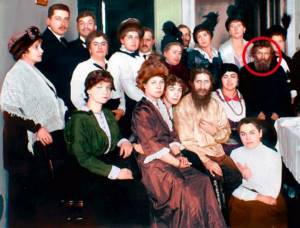
“The Elder” with fans of his bathhouse method of expelling sins. Akulina, as always, is at his feet. Photo: legion-media.ru
Conspiracy and murder
Before committing the murder of Grigory Rasputin, his opponents tried to destroy him spiritually. He was accused of whipping, witchcraft, drunkenness, and depraved behavior. But Nicholas II did not want to take into account any arguments, since he firmly believed in the elder and continued to discuss all state secrets with him.
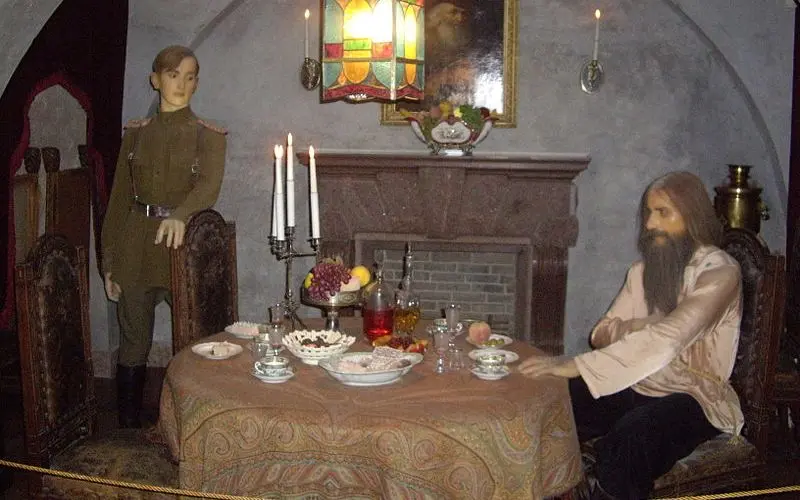
Wax figures of Felix Yusupov and Grigory Rasputin / Nikolay Mylyuev, Wikipedia
Therefore, in 1914, an “anti-Rasputin” conspiracy arose, initiated by Prince Felix Yusupov, Grand Duke Nikolai Nikolaevich Jr., who later became the commander-in-chief of all military forces of the Russian Empire during the First World War, and Vladimir Purishkevich, who was an actual state councilor at that time.
It was not possible to kill Grigory Rasputin the first time - he was seriously wounded in the village of Pokrovskoye by Khionia Guseva. During that period, while he was on the verge between life and death, Nicholas II decided to participate in the war and announced mobilization. At the same time, he continued to consult with the recovering seer about the correctness of his military actions, which again was not part of the plans of the royal ill-wishers.
Therefore, it was decided to bring the conspiracy against Rasputin to the end. On December 29 (new style), 1916, the elder was invited to the Palace of Prince Yusupov to meet with the famous beauty, the prince's wife Irina, who needed the healing help of Grigory Efimovich. There they began to treat him to food and drinks poisoned by poison, but potassium cyanide did not kill Rasputin, which forced the conspirators to shoot him.
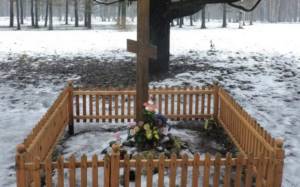
The place of the supposed burial of the remains of Grigory Rasputin in Piskarevsky Park / Monoklon, Wikipedia
After several shots in the back, the elder continued to fight for life and was even able to run out into the street, trying to hide from the killers. After a short chase, accompanied by gunfire, the healer fell to the ground and was severely beaten by his pursuers. Then the exhausted and beaten old man was tied up and thrown from the Petrovsky Bridge into the Neva. According to historians, once in the icy water, Rasputin died only a few hours later.
Nicholas II entrusted the investigation into the murder of Grigory Rasputin to the director of the Police Department, Alexei Vasiliev, who got on the “trail” of the killers of the healer. 2.5 months after the death of the elder, Emperor Nicholas II was overthrown from the throne, and the head of the new Provisional Government ordered a hasty end to the investigation into the Rasputin case.
Personal life
The personal life of Grigory Rasputin is as mysterious as his fate. It is known that back in 1900, during a pilgrimage to the holy places of the world, he married a peasant pilgrim like himself, Praskovya Dubrovina, who became his only life partner. Three children were born into the Rasputin family - Matryona, Varvara and Dmitry.
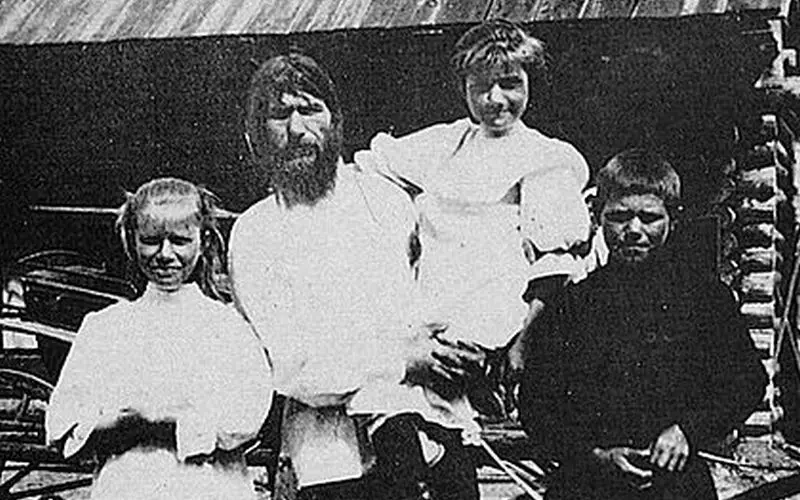
Grigory Rasputin with children / Chronos
After the murder of Grigory Rasputin, the elder’s wife and children were subjected to repression by the Soviet authorities. They were considered “evil elements” in the country, so in the 1930s the entire peasant farm and the house of Rasputin’s son were nationalized, and the healer’s relatives were arrested by the NKVD and sent to special settlements in the North, after which their trace was completely lost. Only the daughter Matryona Rasputina managed to escape from the hands of the Soviet regime, who emigrated to France after the revolution and then moved to the USA.
Predictions of Grigory Rasputin
Despite the fact that the Soviet authorities considered the elder a charlatan, the predictions of Grigory Rasputin, which he left on 11 pages, were carefully hidden from the public after his death. In his “testament” to Nicholas II, the seer pointed out that several revolutionary coups had taken place in the country and warned the tsar about the murder of the entire imperial family “ordered” by the new authorities.
Rasputin also predicted the creation of the USSR and its inevitable collapse. The elder predicted that Russia would defeat Germany in World War II and become a great power. At the same time, he foresaw terrorism at the beginning of the 21st century, which would begin to flourish in the West.
Embed from Getty Images Elder Grigory Rasputin
In his predictions, Grigory Efimovich did not ignore the problems of Islam, clearly indicating that Islamic fundamentalism is emerging in a number of countries, which in the modern world is called Wahhabism. Rasputin argued that at the end of the first decade of the 21st century, power in the East, namely Iraq, Saudi Arabia and Kuwait, would be seized by Islamic fundamentalists who would declare "jihad" on the United States.
After this, according to Rasputin’s predictions, a serious military conflict will arise, which will last 7 years and will be the last in human history. True, Rasputin predicted one big battle during this conflict, during which at least a million people would die on both sides.


